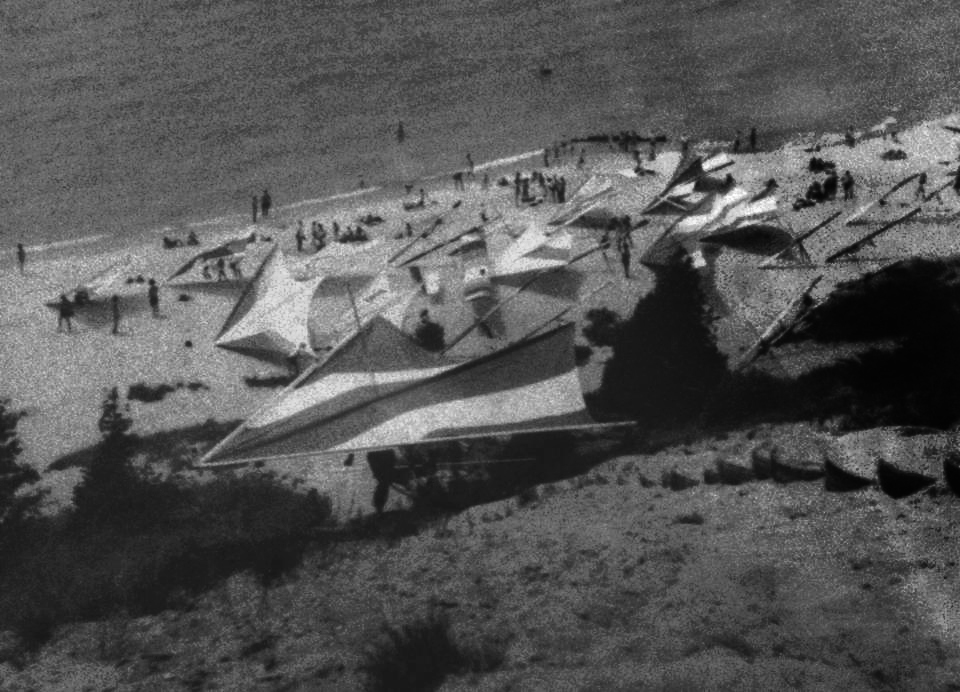A history of Benzie’s airfields
As a high school student in 1938, Bob Laubach had more than the usual distractions outside his classroom window. On sunny days, shadows cast from airplane wings danced silently over school grounds as planes glided toward landing on the Frankfort Airport turf strip.
The first successful flight of a Michigan-built glider (manned, unpowered plane) was in 1909. By 1937, magazines such as National Geographic, The Saturday Evening Post, Reader’s Digest and Life touted the Frankfort and Elberta area as one of the nation’s premier spots for “soaring”, the hobby of glider plane enthusiasts. During this time, national soaring meets took place in two locations each year: Elmira, New York and Frankfort. The Northwest Soaring Club eventually established its headquarters as the Frankfort Airport.
One of the mandates from The Servicemen’s Readjustment Act of 1944 (informally known as the G.I. Bill) provided free flight instruction to servicemen returning from World War II. A flight school was established in Frankfort, bringing additional business to Frankfort’s Dow Memorial Field.
When Laubach returned from serving in WWII, he became an active member of the Frankfort Airport Authority for several years. In the late 1950s, he was instrumental in finding matching federal funds for needed airport improvements.
Originally the Frankfort Airport had two runways, one facing north/south, and one east/west. Lake Michigan air currents sometimes caused unstable conditions for takeoff and landing, and the airport was the scene of fatal accidents in 1947, 1949 and 1960.
Under direction of the Federal Aviation Administration (FAA) the raised funding was used in 1961 to eliminate the original runways and build one paved 2800-foot runway facing northwest/southeast (with lighting capability). In 2006, the runway was lengthened to its present 4050 feet, and the current terminal building was added, providing an indoor seating area and additional amenities for airport patrons.
Although the Northwest Soaring Club moved operational headquarters from Frankfort to Cadillac in 2011, Frankfort’s Dow Memorial Field continues to be the area’s busiest small recreational air hub.
“We’re the only area airport, other than Traverse City and Manistee, offering fuel on site,” said Frankfort’s current manager Jay Darling. “In the summer season, we’ve sometimes accommodated more than 500 flights a month.” Dow Memorial Field remains open year-round, although winter conditions do cause the runway to be closed as necessary. “We have to make decisions on those sub-zero days, knowing we need to use common sense for our equipment, and stay within our budget,” noted Darling.
Although Frankfort’s airport (owned by the Frankfort City-County Airport Authority) is the area’s busiest, there are 10 more airports recognized by the FAA located in the Sleeping Bear area. The second busiest is the Thompsonville Airport, owned by the Village of Thompsonville.
In the late 1940s, Benzie County citizens successfully blocked a military effort to create an airbase in Homestead Township near Interlochen. The Homestead Airbase would have needed a 12,000-foot runway to accommodate takeoff and landings of B-52 fighter planes, and citizens were concerned with noise impact on the nearby National Music Camp (now Interlochen Academy of Arts). The Thompsonville Airport was built shortly after the Homestead Airbase defeat, as a vehicle for the area’s casual flight enthusiasts.
Today, the Thompsonville Airport, offers two runways (one turf and one asphalt). Thompsonville Airport Manager Tim Windrim says the airport traffic is a good mix of local enthusiasts and tourists. “Some of the summer folks would rather land over here (in Thompsonville) because the wind situation is a little better than in Frankfort,” Windrim said.
Thompsonville Airport is the primary base for the Benzie Area Radio Controllers (BARC), a private club whose members build and fly small radio-controlled aircraft. Two major fund-raising events are hosted each year by BARC, with the public being encouraged to attend. In 2014, the Spring Thing (one of the largest radio controlled flying events in Michigan) will be May 17. Spring Thing proceeds will primarily fund needed airport improvements. The Summer Air Show will be held August 23, with proceeds being given to the Wounded Warrior Project.
Sleeping Bear airports cater mainly to summer visitors and local air enthusiasts. The majority are open to the public, although some private airstrips also allow public use after permission is granted. Although private air flight dropped sharply during the recent economic recession, the Sleeping Bear Dunes National Lakeshore’s recognition in 2011 as “the most beautiful place in America” by the Good Morning American TV show helped spark a renewed interest. Benzie County may be Michigan’s smallest, but it’s one of the richest both in aviation history and future possibilities.
Sleeping Bear area airports are sometimes staffed during the busy summer season. However, since employees of small local airports are often employed elsewhere, manned hours can be irregular. Runways have wind socks, but most do not have lights. Takeoff and landing decisions are made at the discretion of individual pilots according to weather conditions and competing air traffic. Those interested in using these airports can call ahead to learn of runway conditions or any obstructions, or to receive any needed permission for landing.
For more information, call the Frankfort City Council Airport Authority at (231) 352-9118 or the Village of Thompsonville at (231) 378-2575.




